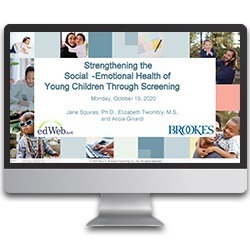
We hope you enjoyed the recent edWebinar on Supporting the Social-Emotional Health of Young Children Through Screening presented by Jane Squires, Ph.D., Elizabeth Twombly, M.S., and Alicia Ginardi.
In this Q&A, we’re diving into the questions from listeners that we didn’t get to cover in the live webinar.
Q: Should schools have parents complete both ASQ®-3 and ASQ®:SE-2?
Yes, we recommend that all young children be screened with both a developmental screening tool (e.g., ASQ-3) and a social-emotional screening tool (e.g., ASQ:SE-2). Using both types of tools allows you to have a more complete picture of a child’s overall development.
Read this article to learn more about the benefits of using both ASQ-3 and ASQ:SE-2 together
Q: What are your suggestions for parents that resist or refuse to complete the questionnaire?
If a parent refuses or resists completion of the questionnaire, the first step would be to determine why they are hesitant to screen their child. Has the child recently been screened by another service provider (e.g., the child’s pediatrician)? Is the parent stressed and does not feel they have the time to complete the screening? Is the parent mistrustful of systems, or have they had negative personal experiences with early intervention or special education? Is the parent holding concerns about their child, but not ready or fearful about facing these concerns?
The screening process should be led by parents, and it should be in their control. Providing a personal introduction to parents about the purpose and benefits of screening is an important first step to engaging parents in the process. Use this tip sheet as a guide when introducing ASQ:SE-2 to parents.
Providing support, as needed, to complete the questionnaire and always reminding parents that they are in control of any next steps may reassure them about the process. Finally, sometimes parents need time to build trust in teachers, service providers, and agencies. Take some time to develop relationships with parents and make sure they know you care about and want the best for their child before introducing screening.
Q: We find that not all parents are honest on ASQ questionnaires as they are afraid that their child might not be enrolled if they tell the truth. How should we handle this?
When parents enroll children in your school or program, share information about your screening system. Make sure parents understand how the results of ASQ will be used and reassure parents that the results are NOT used to exclude children from the program. When parents understand the purpose of screening and how follow-up can benefit their child, they are much more likely to feel comfortable reporting on their child’s development and discussing concerns with service providers.
Q: How should we respond when families do not want a referral?
Sometimes parents need time. There may be more pressing issues or needs in their families, or they may need to emotionally prepare for the referral. Give parents time and support them when they are ready to take those next steps. Provide in-house support and preventative activities—and rescreen (monitor) the child closely. The most important thing teachers and service providers can do is maintain a supportive relationship with parents and help them take next steps when they are ready.
You may also want to share some activities with the parent to help them promote their child’s skills. Share these developmental activities and social-emotional activities with parents.
Q: We have kids in foster care due to child protective services issues with the family. Should both the foster parent and parent fill out an ASQ:SE-2?
Only caregivers who spend 15–20 hours per week with a child should complete ASQ:SE-2 questionnaires. If a child is in the foster care system, usually parents do not have that many hours of visitation per week, so they would not be able to provide an accurate report of the child’s behavior/social-emotional development.
At any time, sharing guidance about social-emotional development is important for both parents AND foster parents. ASQ®:SE-2 Learning Activities & More includes a newsletter that describes social-emotional development at each age/stage. The parent–child activities give parents ideas of how to interact with their child to support social-emotional development. And, finally, tip sheets on specific topics of concern may provide guidance and strategies to help support their child’s development. See a sample.
Once parents are reunited with their child, screening with the ASQ-3 and ASQ:SE-2 and providing ongoing follow-up and support is important to support their parenting journey!
Q: Where can we find training for ASQ?
There are some introductory training materials available on www.agesandstages.com, including an Introduction to ASQ-3 presentation and Introduction to ASQ:SE-2 presentation. The ASQ training DVDs are also a helpful resource.
Live virtual training is also available through Brookes on Location, our professional development program. Learn more.
Q: How can teachers use ASQ with children while teaching remotely?
Many schools and programs are using ASQ to screen virtually during the health crisis. Some schools are mailing questionnaires to parents for completion, while others are having teachers complete the questionnaires through interviews with parents via telephone or video conference. Some programs are using ASQ® Family Access, which allows parents to complete questionnaires online.
We have created a resource page to help programs conduct virtual screening during the health crisis: https://agesandstages.com/using-asq-in-a-virtual-environment/ We encourage you to watch the recorded webinars on using ASQ-3 and ASQ:SE-2 with families virtually.
A special release of ASQ-3 and ASQ:SE-2 English and Spanish questionnaire files in JPEG format is available for use through June 30, 2021. These files can be texted to families for reference during completion via phone call or video conference.
To learn more about online questionnaire completion, we invite you to join us for a live demo.
Q: Are the activities in the ASQ:SE-2 Learning Activities & More also in the User’s Guide?
The ASQ®:SE-2 User’s Guide contains intervention activities to share with parents, as well as social-emotional development guides for each age ranges; you can see these resources here.
The activities included in the ASQ:SE-2 Learning Activities & More are additional activities to support social-emotional development. The activity sheets are available in a colorful, friendly format to share with families via email or on paper. ASQ:SE-2 Learning Activities & More also contains social-emotional development newsletters and tip sheets on important topics for families. See a sample.
This chart shows the various materials in the ASQ:SE-2 Learning Activities & More. Read this article on using the Learning Activities book to support children’s development.
Q: Do the ASQ:SE-2 Learning Activities offer strategies if the child is above the cutoff (in the referral zone)?
Yes! The learning activities are appropriate for any child, regardless of the child’s ASQ:SE-2 result. However, parents may need support and/or coaching to use strategies effectively.
Parents who have children with significant behavioral challenges will need more support than the learning activities can offer. Resources from the National Center on Pyramid Model Innovations may be helpful for these parents.
Q: How do I get ASQ:SE-2 materials?
ASQ:SE-2 can be purchased through Brookes Publishing. The screening tool is sold as a Starter Kit containing photocopiable masters of the 9 questionnaires (2, 4, 6, 12, 18, 24, 30. 36, 48, and 60 months); a CD-ROM with printable PDFs of all 9 questionnaires; and a User’s Guide.
You can use code EDWEBASQ to save 20% on ASQ:SE-2 and other Brookes Publishing products through 12/31/20.
Q: Do you have a good resource to go to help with conversion from paper to online screening?
Schools and programs subscribing to our ASQ Online system have access to a robust help section, including tutorials and searchable manuals. We also offer implementation support via email to help programs transition to online screening.
Q: How can I get the handouts from the webinar?
We’ve included links below to all the resources shared during the edWebinar.
Slide Handouts
Social-Emotional Activities for Parents
Social-Emotional Activities for Parents (Spanish)
Social-Emotional Development Guide poster
Getting Ready for Kindergarten handout (sample from ASQ:SE-2 Learning Activities & More)
Getting Ready for Kindergarten handout in Spanish (sample from ASQ:SE-2 Learning Activities & More)
Helping Your Child Calm Down handout (sample from ASQ:SE-2 Learning Activities & More)
Stress and Your Child handout (sample from ASQ:SE-2 Learning Activities & More)
-

What ASQ Users are Saying
“What I love about the ASQ is that it allows our staff to catch delays quickly and allows us to get our clients the early intervention programs that they sometimes need. In many cases [ASQ] helps us catch children up before they start kindergarten, therefore providing children with the start that they deserve.”
Sharon Gee, Supervisor, Healthy Families Niagara

